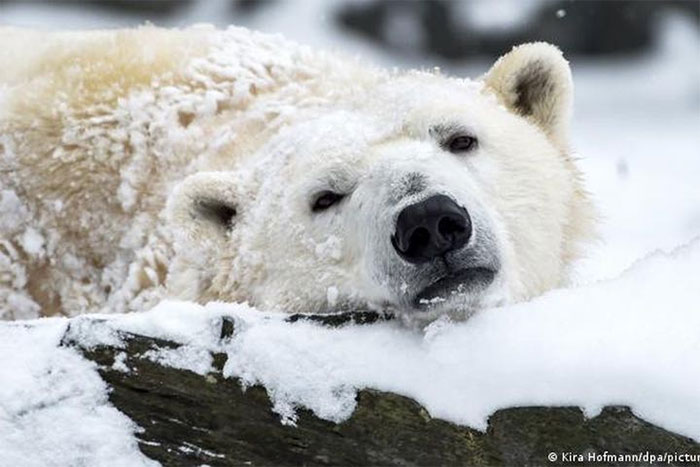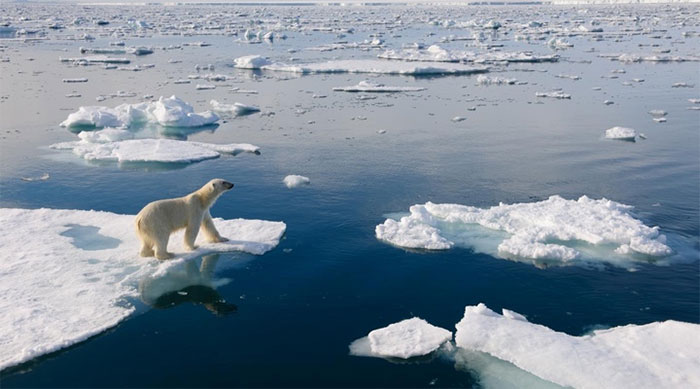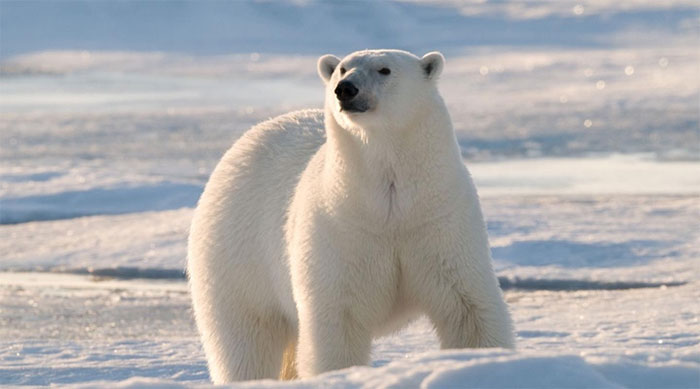The Polar Bear is a large mammal of the carnivore order. They are animals that live near the poles, found around the Arctic Ocean, and are the largest land carnivores.
Interesting Facts About Polar Bears
- 1. Polar Bears are classified as marine mammals
- 2. Polar Bears are actually black
- 3. They can swim continuously for many days
- 4. The success rate of a Polar Bear’s hunting trip is less than 2%
- 5. Scientists can extract Polar Bear DNA from their footprints
- 6. Polar Bears face many threats beyond climate change
- 7. There are hybrid species between Grizzly Bears and Polar Bears
- 8. There are approximately 19 Polar Bear populations
- 9. A male Polar Bear can weigh as much as 10 men
- 10. They can smell prey from 10 kilometers away
1. Polar Bears are classified as marine mammals
This is because they spend most of their lives in the icy waters of the Arctic Ocean, viewing the ocean as both a habitat and a food source. Polar Bears are the only bear species classified as marine mammals.
2. Polar Bears are actually black
The fur of Polar Bears is translucent. We see Polar Bears as white only because their fur reflects visible light. Beneath that thick fur coat is black, shiny skin.
3. They can swim continuously for many days

Polar Bears can swim long distances continuously for hours.
In addition to reaching maximum speeds of nearly 10 km/h while swimming, Polar Bears can swim long distances continuously for hours to move from one ice floe to another. Their large paws are specially adapted for swimming, and they use their paws to paddle through the water while keeping their back legs straight like a rudder.
4. The success rate of a Polar Bear’s hunting trip is less than 2%
Although Polar Bears spend half their lives hunting for food, these trips rarely succeed. Their main prey includes ringed seals and bearded seals, although they also hunt smaller mammals, birds, eggs, and even vegetation.
5. Scientists can extract Polar Bear DNA from their footprints
A groundbreaking technique developed by WWF and the DNA company SPYGEN allows scientists to isolate DNA from the footprints of a Polar Bear in the snow. Just two small shovels of snow from a Polar Bear’s path can reveal not only its DNA but even the DNA of the seal it just ate.
6. Polar Bears face many threats beyond climate change
While climate change is the biggest threat to the survival of Polar Bears, it is not the only concern for this predator. The oil and gas industry is moving into the Arctic, and with this extraction comes potential risks that could destroy the habitats of wildlife.

Polar Bears can be chemically contaminated by pesticides through their prey.
Exposure to oil spills can reduce the insulating properties of Polar Bear fur, causing them to expend more energy to stay warm, and can lead to poisoning if ingested. Polar Bears can also suffer from chemical contamination such as pesticides through their prey, affecting their biological functions and reproductive capabilities.
Melting ice due to climate change has increased the frequency of human-Pole Bear conflicts, as bears become desperate for food during the summer. Fortunately, humans have learned to adapt to the presence of Polar Bears and have implemented solutions to reduce conflict risks.
7. There are hybrid species between Grizzly Bears and Polar Bears
In 2006, a genetic test confirmed the existence of a hybrid bear species between Grizzly Bears and Polar Bears, called the “grolar bear” or “pizzly bear” (a blend of Grizzly and Polar). The physical characteristics of this hybrid are a combination of the two parent species, but since hybrids are often born to female Polar Bears, they are raised and behave more like Polar Bears. The ability for Grizzly Bears and Polar Bears to hybridize is not surprising if you know that Polar Bears actually evolved from brown bears around 150,000 years ago.
8. There are approximately 19 Polar Bear populations

Male Polar Bears can weigh up to 800kg and are twice the size of females.
With a population of approximately 26,000 wild Polar Bears, they are divided into 19 groups or populations. Among these, only one population is increasing, five populations are stable, and four are declining. The remaining nine populations have not been surveyed due to a lack of data – we simply do not have enough information to assess their current status.
9. A male Polar Bear can weigh as much as 10 men
A male Polar Bear can weigh up to 800 kg and is twice the size of a female. This, combined with their length of up to 3 meters, makes Polar Bears the largest terrestrial carnivores in the world.
10. They can smell prey from 10 kilometers away
Polar Bears have an extremely strong sense of smell, which they use to detect seals breathing through holes in the ice. Once they locate a hole, the bear will patiently wait until the seal appears and then rush in to attack. They can even detect a seal swimming in water one meter deep beneath thick ice.





















































